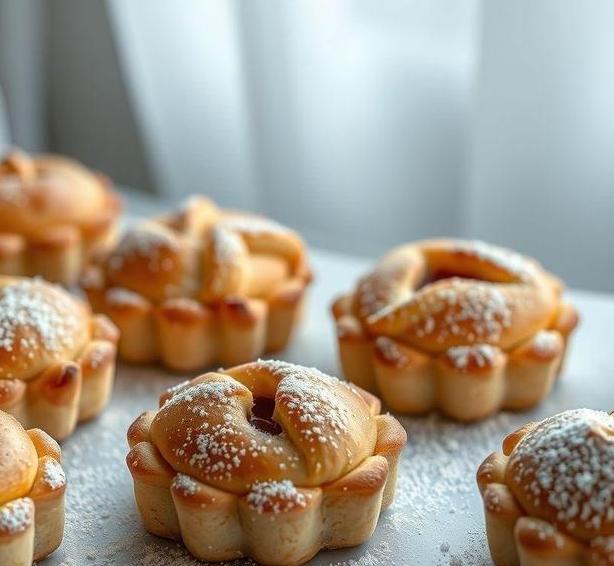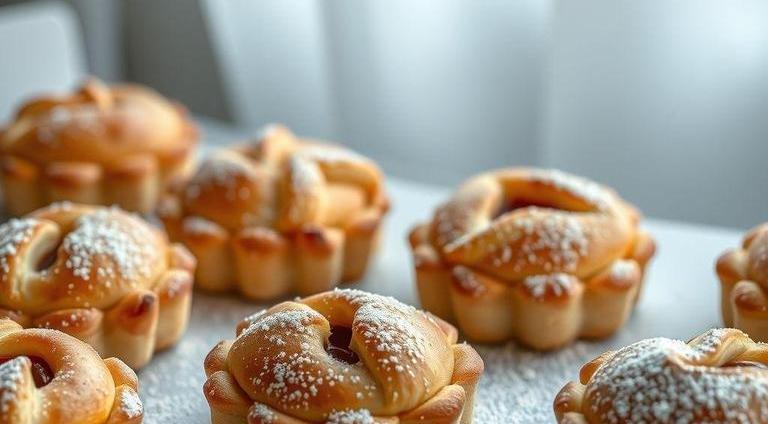Shortcrust pastries, with their delicate, crumbly texture and buttery flavor, are a baking staple that can elevate both savory and sweet dishes. Whether you’re making pies, tarts, quiches, or hand pies, shortcrust pastry provides the perfect base. But, like any baked good, it doesn’t last forever. Over time, shortcrust pastries can degrade in flavor and texture, especially if not stored correctly. This raises a very important question: Can shortcrust pastries go bad?
In this guide, we’ll explore everything you need to know about the shelf life of shortcrust pastries, the signs of spoilage, how to store them properly to extend their freshness, and expert tips to ensure that your pastries stay perfect for as long as possible.
Can Shortcrust Pastries Go Bad?
Yes, shortcrust pastries can absolutely go bad, though they don’t spoil in the same way as, say, dairy products or fresh fruits. Over time, the flavor and texture of shortcrust pastry can degrade, and in some cases, it may become unsafe to eat if exposed to the wrong conditions.
- Texture Loss: One of the most common ways shortcrust pastry ’goes bad’ is by becoming stale or soggy. The crisp, flaky texture that defines a great shortcrust pastry can become limp and unappealing if not properly stored or if it absorbs moisture.
- Flavor Degradation: The richness and buttery flavor that make shortcrust pastry so delightful can also diminish with time. If kept in a warm or humid environment, it can develop off-flavors, especially if exposed to air, which causes oxidation.
- Microbial Growth: While it’s rare, shortcrust pastry can spoil in a more traditional sense, mainly due to any ingredients that might have been added to it. For example, if you’ve included dairy products like cream or milk in your filling or if you’ve left your pastry exposed for too long, mold or bacteria can grow.
Shelf Life For Shortcrust Pastries

The shelf life of shortcrust pastries can vary depending on a variety of factors, including whether they’re homemade or store-bought, and how they’re stored. Here’s a breakdown to give you a clearer picture:
-
Homemade Shortcrust Pastry
- Freshly Baked: If you’ve baked your shortcrust pastry and it’s still fresh, it will typically last 2-3 days at room temperature in a sealed container.
- Unbaked Dough: Raw shortcrust pastry dough can be stored in the refrigerator for up to 3 days. You can also freeze it for up to 3 months, but be sure to wrap it tightly to avoid freezer burn.
-
Store-Bought Shortcrust Pastry
- Unopened Packaged Pastry: Store-bought, pre-made shortcrust pastry (whether frozen or refrigerated) will generally last several weeks to a few months, depending on the packaging and the expiration date.
- After Opening: Once opened, it’s best to use it within 5-7 days when refrigerated, though its shelf life can extend if frozen.
-
Shortcrust Pastry With Fillings
- If your pastry has been filled (like a pie or tart), its shelf life will be shorter. Typically, filled shortcrust pastries should be consumed within 2-3 days if stored in the fridge. If frozen, they can last up to 1-2 months but might lose some of their texture once thawed.
Common Signs Of Spoilage
Knowing when your shortcrust pastry has gone bad is crucial for both safety and flavor. Here are some common signs that your pastry might no longer be good to eat:
- Off Smell: The most obvious sign of spoilage is a sour or rancid smell. This is especially true if your pastry has been sitting around too long or stored improperly. If it smells off, discard it.
- Discoloration: While shortcrust pastry is usually pale, look for any odd discoloration-especially a yellowing or darkening of the dough, which may indicate oxidation or the start of mold.
- Mold: Mold growth is a definite red flag. If you spot any fuzzy or greenish spots, don’t hesitate to throw the pastry away, as mold can produce harmful toxins.
- Soggy or Sticky Texture: Shortcrust pastry should feel dry and crumbly to the touch. If it becomes overly soft, soggy, or sticky, it’s a sign that it’s absorbed too much moisture and is no longer fresh.
- Rancid Flavor: A buttery, slightly bitter, or off-flavor can also indicate spoilage. This could be a result of the fats in the pastry going rancid.
How To Store Shortcrust Pastries?

Proper storage is the key to preserving the freshness and flavor of shortcrust pastries. Whether you’re dealing with raw dough or baked goods, here are the best storage practices:
-
For Unbaked Dough
- Refrigerate: Wrap your dough tightly in plastic wrap or place it in an airtight container. Refrigerate for up to 3 days. If you plan on using it later, consider freezing it.
- Freeze: For longer storage, freeze the dough for up to 3 months. Once frozen, wrap it well in plastic and foil. When you’re ready to use it, thaw it in the refrigerator overnight.
-
For Baked Pastries (without Filling)
- Room Temperature: If you’re consuming them within a few days, store your baked shortcrust pastries at room temperature. Keep them in an airtight container or wrapped in wax paper to prevent them from absorbing moisture.
- Freezing Baked Pastries: If you have leftover baked pastries, freeze them. Wrap them individually or in pairs in plastic wrap, then place them in a freezer-safe bag or container. Thaw them at room temperature or in the oven for a few minutes to restore some crispness.
-
For Filled Pastries
- Refrigeration: Filled pastries (like pies or tarts) should always be kept in the fridge due to the perishable nature of the fillings. Use an airtight container to keep them fresh for 2-3 days.
- Freezing: If you want to store filled pastries longer, freezing is an option. Once frozen, filled pastries can last up to 1-2 months. However, be aware that the texture might change once thawed, especially with custard-like fillings.
Expert Tips
Here are some pro tips from bakers and pastry chefs to help you extend the life of your shortcrust pastries and make them taste even better:
- Avoid Humidity: Humidity is the enemy of shortcrust pastry. If you live in a particularly humid climate, be sure to store your pastries in a dry place and use airtight containers to prevent moisture absorption.
- Reheat in the Oven: To restore the flakiness of shortcrust pastry that has gone soft, pop it in the oven for a few minutes. This will help the butter in the pastry re-melt and regain some of its original crispness.
- Use Parchment Paper: When freezing, wrapping your dough or baked goods in parchment paper before plastic wrap can help prevent it from sticking and improve the ease of handling.
- Prevent Freezer Burn: When freezing, use freezer-safe bags and try to remove as much air as possible to avoid freezer burn, which can affect both texture and flavor.
FAQs
How Long Do Shortcrust Pastries Last?
Shortcrust pastries typically last for about 2 to 3 days when stored in an airtight container at room temperature. For longer storage, you can refrigerate them for up to a week or freeze them for up to 3 months.
Can Shortcrust Pastries Go Bad If Left Out Overnight?
Yes, shortcrust pastries can go bad if left out overnight, especially if the filling contains perishable ingredients like dairy or eggs. They should be stored in an airtight container to prevent staleness and contamination.
How Can I Tell If Shortcrust Pastries Have Gone Bad?
Signs that shortcrust pastries have gone bad include a rancid smell, visible mold, discoloration, or a soggy texture. If the pastries have been stored improperly or past their shelf life, these are indicators they should be discarded.
Can I Eat Shortcrust Pastries After The Expiration Date?
It depends on how the shortcrust pastries have been stored. If kept properly in the fridge or freezer, they may still be safe to eat past the expiration date. However, it’s essential to check for any signs of spoilage, such as mold or an off smell.
Is It Safe To Eat Shortcrust Pastry With A Soft Or Soggy Texture?
A soft or soggy texture in shortcrust pastry usually indicates that it has absorbed moisture, which may cause it to spoil. If the pastry has an off smell or taste, it’s best to discard it to avoid foodborne illness.
How Should I Store Shortcrust Pastries To Prevent Them From Going Bad?
To prevent shortcrust pastries from going bad, store them in an airtight container at room temperature for up to 2 to 3 days. For longer storage, refrigerate or freeze them. Always make sure they are completely cooled before storing.
Can Freezing Shortcrust Pastries Affect Their Quality?
Freezing shortcrust pastries can preserve them for months, but it may affect their texture. Pastries may become slightly more crumbly after thawing. To minimize quality loss, wrap them tightly in plastic wrap or foil before freezing.
What Is The Shelf Life Of Shortcrust Pastry Dough?
Shortcrust pastry dough can be refrigerated for up to 2 days or frozen for up to 3 months. It is best to use the dough within these time frames for optimal texture and flavor.
Can I Prevent Shortcrust Pastries From Getting Stale?
To prevent shortcrust pastries from getting stale, store them in an airtight container, away from heat and humidity. If they start to lose crispness, you can gently reheat them in the oven to restore some of their texture.
Are There Any Specific Ingredients In Shortcrust Pastry That Can Spoil Faster?
Yes, shortcrust pastries with fillings containing dairy, eggs, or fresh fruits tend to spoil faster. It’s important to store these pastries in the refrigerator and consume them within a few days to avoid food safety issues.